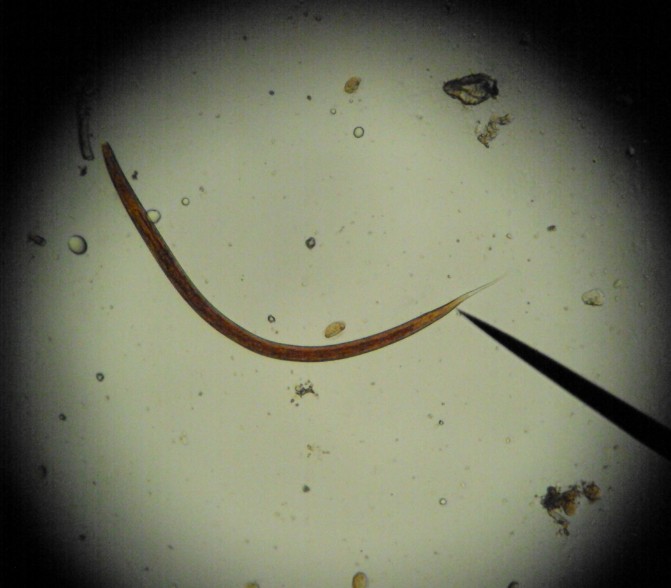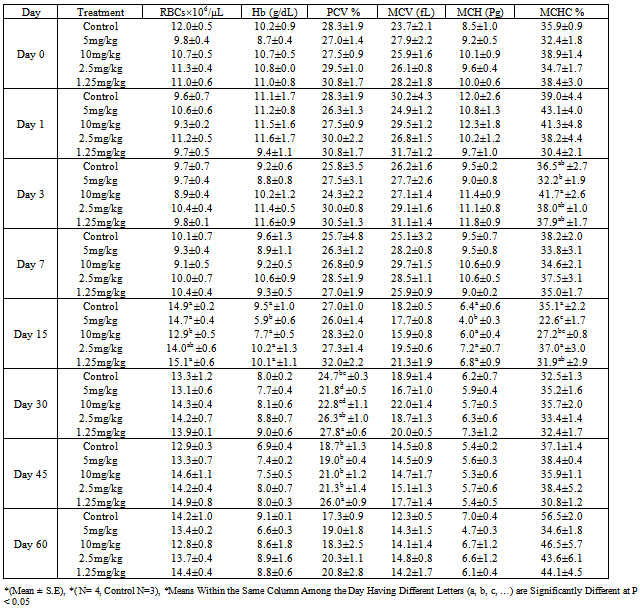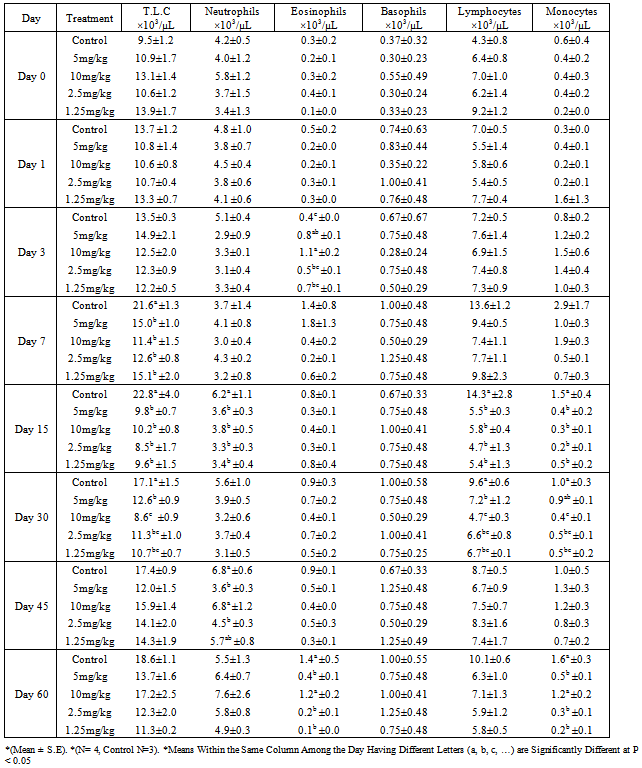-
Paper Information
- Next Paper
- Previous Paper
- Paper Submission
-
Journal Information
- About This Journal
- Editorial Board
- Current Issue
- Archive
- Author Guidelines
- Contact Us
Research in Zoology
p-ISSN: 2325-002X e-ISSN: 2325-0038
2013; 3(1): 31-37
doi:10.5923/j.zoology.20130301.05
Efficacy and Safety of Albendazole against Haemonchus Contortus Infestation in Goats
Mostafa-Fayez M. Hassan1, Hatem A. Gammaz1, Mohamed M. Abdel-Daim1, Yassein M. Abdoel-Motalab2, Khalid M. Mohammedsalih1, 2
1Department of Pharmacology, Faculty of Vet. Medicine, Suez Canal University, Egypt
2Faculty of Veterinary Science, University of Nyala, Sudan
Correspondence to: Khalid M. Mohammedsalih, Department of Pharmacology, Faculty of Vet. Medicine, Suez Canal University, Egypt.
| Email: |  |
Copyright © 2012 Scientific & Academic Publishing. All Rights Reserved.
A field study was aimed to evaluate the efficacy and safety of albendazole administered orally at different dose regimens in goats naturally infested with Haemonchus contortus. Nineteen male goats’ allocated to five groups (N= four, control N= three) were used. The first group served as the untreated control. Albendazole was given as a single dose for the second and third group at dose 5 and 10 mg/kg body weight (BW) respectively. The fourth group received 2.5 mg/kg BW repeated for four days while the fifth group given 1.25 mg/kg BW repeated for eight days. Faecal and blood samples were collected at zero, one, three, seven, 15, 30, 45 and 60 days of drug administration. The results of faecal egg count reduction% revealed that, the group received 5 mg/kg BW as a single dose had ≥ 95 % on the day three and seven, the group received 10 mg/kg BW as a single dose had ≥ 95 % on day three, the group received 2.5 mg/kg BW repeated for four days had ≥ 95 % on the day three, seven and 15, group received 1.25 mg/kg BW repeated for eight days had ≥ 95 % on the day three, seven, 15 and 30. The results of PCV % revealed a significant (P < 0.05) increase in the group received 1.25 mg/kg BW repeated for eight days on day 30 and 45. The results of the total leukocyte count revealed a significant (P < 0.05) decrease in treated groups when compared to control on day seven, 15 and 30. The results of biochemical analysis revealed a significant (P < 0.05) increase in the level of albumin in the group received 1.25 mg/kg BW repeated for eight days on day 45. It was concluded that, administration of albendazole at small repeated doses proved to have a satisfactory efficacy and safety in the treatment and control of H. contortus in goats.
Keywords: Albendazole, Haemonchus contortus, Male Goats
Cite this paper: Mostafa-Fayez M. Hassan, Hatem A. Gammaz, Mohamed M. Abdel-Daim, Yassein M. Abdoel-Motalab, Khalid M. Mohammedsalih, Efficacy and Safety of Albendazole against Haemonchus Contortus Infestation in Goats, Research in Zoology, Vol. 3 No. 1, 2013, pp. 31-37. doi: 10.5923/j.zoology.20130301.05.
Article Outline
1. Introduction
- Infestation of gastrointestinal nematodes remains one of the major constraints in ruminant production. Among the gastrointestinal nematodes, H. contortus is the species with the greatest pathologic and economic importance. This nematode is a blood feeding abomasal parasite of sheep and goats but can circulate in other ruminant species such as cattle and reindeer[1, 2]. Treatment and control of H. contortus infestation could result in improving performance of the farm animals specially goats[3].Albendazole, a benzimidazole derivative, is authorized for use in veterinary medicine, and has been used for decades in the treatment and control of gastrointestinal nematodes as well as liver flukes[4]. Albendazole was highly efficacious in the removal of mono-specific and mixed infection of H. contortus and other gastrointestinal nematodes in sheep and goats[5]. Furthermore, Craig and Shepherd[6] reported that, albendazole produced an effect more than 98% against H. contortus infestation. Additionally, Theera et al.[7] reported that, albendazole was proven to have a satisfactory efficacy in the treatment and control of H. contortus infestation in ruminant, particularly in a herd with no history of albendazole uses.This study attempted to determine the optimal therapeutic regimen of albendazole for treatment and control of H. contortus infestation in goats. Furthermore, to evaluate the effect of albendazole at different doses and regimens on hematological and some serum biochemical parameters of goats.
2. Materials and Methods
2.1. Experimental Drug
- Albendazole 2.5% suspension® (Pharma Swede, Egypt).
2.2. Study Area and Study Animals
- This study was performed on the farm of the Faculty of Veterinary Science, University of Nyala, Nyala, South Darfur State, Sudan. A total of 19 male goats, five to ten months old, 15-19 Kg BW, were purchased from Almawashi marked (Nyala). Before purchased, the animals were examined to provide infestation with H. contortus using the flotation technique as described by Soulsby[8]. H. contortus eggs were identified on the basis of their morphological features[9]. Furthermore, before starting the study, some faecal samples were cultured to confirm the identified eggs by recognizing H. contortus larvae (L3), using the method described by Litchenfels[10]. Experimental animals maintained free (untie) in locally made pen and allowed free to graze during the day and provided with additional feed at night with free access to water. Study animals treated with a broad spectrum antibacterial drug enrofloxacine (Avitryl®-5) at dosage 2.5 mg/kg BW subcutaneously repeated for three days as umbrella treatment against bacterial infection. The animals kept for two weeks before starting the study to be adapted to environment.
2.3. Experimental Design, Treatments and Sampling
- Experimental animals were divided into five groups each of four animals and control group had three animals. The first group served as the untreated control. Albendazole suspension was given orally as a single dose for the second group at dose 5 mg/kg BW, which reported by manufacturer [11] and for the third group at 10 mg/kg BW[12]. The fourth group received 2.5 mg/kg BW repeated for four days while the fifth group given 1.25 mg/kg BW repeated for eight days.Faecal and blood samples were collected at zero, one, three, seven, 15, 30, 45 and 60 days of drug administration. Blood samples were divided into two parts, anticoagulant ethylene diamine tetra acetic acid (EDTA) was added to the first part which used for the determination of hematological parameters. The second part of blood samples left to clot at room temperature then centrifuge for ten minutes at 3000 r.p.m to obtain clear sera. The sera were labelled and stored at −20 Cº until used for biochemical analysis.
2.4. Assessing the Efficacy of Albendazole
- Modified McMaster technique[13] was followed for the faecal egg count. The egg count was expressed in egg per gram (EPG). The faecal egg count reductions (FECR %) based on averages were calculated using the following formula; FECR % =[ 1 – (EPG treatment / EPG control) ] × 100
2.5. Hematological Assay
- Hematological examination such as Packed cell volume (PCV %), haemoglobin (Hb), total erythrocyte count (RBC), blood indices[mean corpuscular volume (MCV), mean corpuscular haemoglobin (MCH), mean corpuscular haemoglobin concentration (MCHC)], total white blood cells count (WBC) and differential cells count were calculated manually[14].
2.6. Biochemical Assay
- Total proteins, albumin, globulins, serum aspartate amino transferase (AST), urea and creatinine were determined[14] using ready-made kits of BioSystem®, Spain and Crescent diagnostics®, Saudi Arabia.
2.7. Statistical Analysis
- Statistics were calculated with SPSS version 20 for windows, the mean values obtained in the different groups were compared by one-way ANOVA, and the least significant difference was used to determine the significant difference between the means of each parameter.
3. Results
3.1. Therapeutic Efficacy of Albendazole
- The results of mean faecal egg count per gram (FPG) and reduction (FECR %) after treatment with albendazole are shown in Table 1. The results revealed that, the group received albendazole at dosage 5 mg/kg BW as a single dose revealed 81.3, 100, 97.4, 85.2, 72.7, - 24.7 and - 19.4 %, the group received 10 mg/kg BW as a single dose revealed 70, 95.7, 73.7, 68.2, 80.9, 14.6 and 11.3%, the group received 2.5 mg/kg BW repeated for four days revealed 73.8, 100, 100, 97.4, 87.7, 55.3 and 55.2%, the group received 1.25 mg/kg BW repeated for eight days revealed 28.8, 97.9, 100, 97.7, 95.4, 67.3 and 61.1% on day 1, 3, 7, 15, 30, 45 and 60 respectively of FECR %.
3.2. Effect on the Hematological Parameters
- Studying erythrogram in different groups (Table 2), the group received albendazole at dosage 5 mg/kg BW as a single dose revealed a significant (P < 0.05) decrease in haemoglobin and MCH on day 15, PCV % on day 30 and MCHC on day three and 15. Furthermore, the group received 10 mg/kg BW as a single dose showed a significant (P < 0.05) decrease on RBC and MCHC on day 15 and PCV % on day 30. On the other hand, the group received 1.25 mg/kg BW repeated for eight days revealed a significant (P < 0.05) increase on PCV % at day 30 and 45. The results of MCV revealed a non significant (P < 0.05) difference between treated groups and control. Studying leukogram in different groups (Table 3), the results revealed a significant (P < 0.05) decrease in total leukocyte count in treated groups when compared to control on day seven, 15 and 30, the decrease refers to a significant (P < 0.05) decrease in neutrophils count on day 15 and lymphocytes and monocytes count on day 15 and 30. Furthermore, the result revealed a significant (P < 0.05) decrease in neutrophils count in the groups received albendazole at dosage 5 mg/kg BW as a single dose and 2.5 mg/kg BW repeated for four days on day 45. The results of eosinophils count revealed a significant (P < 0.05) increase in groups received albendazole at a single dose of 5 and 10 mg/kg BW on day 3. On the other hand, a significant (P < 0.05) decrease in eosinophils and monocytes count revealed on day 60 among treated groups and control.
3.3. Effect on the Biochemical Parameters
- As summarized in Table 4, the results revealed non significant (P < 0.05) effects on the level of serum total proteins, globulins, AST, urea and creatinine within and among treated groups and control. The group received albendazole at dosage 1.25 mg/kg BW repeated for eight days revealed a significant (P < 0.05) increase in the level of serum albumin at day 45. On the other hand, a significant (P < 0.05) decrease in the level of albumin revealed in the group received albendazole at dosage 10 mg/kg BW as a single dose on day 45.
4. Discussion
- Before starting the study, H. contortus eggs identified in the faecal samples of experimental animals (Figure 1) and confirmed by recognizing H. contortus larvae (L3) after faecal samples cultured (Figure 2). At the end of the experiment and according to the confidence of Coles et al.[15], the faecal egg count reduction demonstrated that; albendazole at a single dose of 5 mg/kg BW had ≥ 95 % on day three and seven. These observations were supported by Waruiru[16]. Furthermore, albendazole at a single dose of 10 mg/kg BW had ≥ 95 % on day three. These results in agreement with Mohamed and Al-Farwachi[12] who reported low effectiveness of albendazole at a single dose of 10 mg/kg BW against gastrointestinal nematode infestation in sheep. On the other hand, the results revealed that, albendazole at dosage 2.5 mg/kg BW repeated for four days had ≥ 95 % on day three, seven and 15. Furthermore, albendazole at dosage 1.25 mg/kg BW repeated for eight days had ≥ 95 % on day three, seven, 15 and 30. These results in agreement with Helle[17] who reported that, repeated administration of albendazole at small doses more effective against lung nematode infestation in goats.
 | Figure 1. Haemonchus contortus eggs were examined on day zero |
 | Figure 2. Haemonchus contortus larvae (L3) after faecal samples cultured before starting the study |
|
|
|
5. Conclusions
- This study revealed that, the administration of albendazole at small repeated doses was proved to have a satisfactory efficacy and safety for the treatment and control of H. contortus infestation in goats.
ACKNOWLEDGEMENTS
- The authors would like to thank University of Nyala, Faculty of Veterinary Science and Suez Canal University, Faculty of Veterinary Medicine administrator for their kind assistance. Thanks to massive group for conference and trade fairs for their support for publishing this work.
References
| [1] | Achi, Y. L.; J. Zinsstag; K. Yao; N. Yeo; P. Dorchies and P. Jacquiet (2003). Host specificity of Haemonchus spp. for domestic ruminants in the savannah in northern Ivory Coast. Vet. Parasitol., vol. (116): 151 – 158. |
| [2] | Hrabok, J. T.; A. Oksanen; M. Nieminen; A. Rydzik; A. Uggla and P. J. Waller (2006). Reindeer as hosts for nematode parasites of sheep and cattle. Vet. Parasitol., vol. (136): 297 – 306. |
| [3] | Sujon, M. A.; M. Mostofa; M. S. Jahan; A. R. Das and S. Rob (2008). Studies on medicinal plants against gastrointestinal nematodes of goats. Bangladesh J. Vet. Med., vol. (6): 179 – 183. |
| [4] | Dayan, A. D. (2003). Albendazole, mebendazole and praziquantel. Review of non-clinical toxicity and pharmacokinetics. Acta Trop., vol. (86): 141 – 159. |
| [5] | Theodorides, V. J.; T. Nawalinki and J. Chanq (1976). Efficacy of albendazole against Haemonchus, Dictyocalus and Monieza of sheep. Am. J. Vet. Res., vol. 37(12): 1515 – 6. |
| [6] | Craig, T. M. and E. Shepherd (1980). Efficacy of albendazole and levamisole in sheep against Thysanosoma actinioides and Haemonchus contortus from Edwards Plateau, Texas. Am. J. Vet., vol. 41(3): 425 – 426. |
| [7] | Theera, R.; S. Anawat; A. Korawich and S. Nitis (2005). A Field Study on Efficacy of Albendazole against Gastrointestinal Nematodes in Ruminants. Kasetsart J. Nat. Sci., vol. (39): 647 – 651. |
| [8] | Soulsby, E. J. L. (1986). Helminths, Arthropods and Protozoa of Domesticated Animals. 7th Ed., the ELBS and Baillier Tindall, London, UK. |
| [9] | Thienpont D.; F. Rochette and O. F. J. Vanparijs (1980). Diagnosing helminthiasis through coprological examination. Amer. J. Trop. Med. Hyg., vol. 29(5): 1021. |
| [10] | Litchenfels, J. V. (1986). Scanning microscope of cutucular ridge pattern of H. contortus and H. placei . J. Vet. Parasitol., vol. 76 (2): 327 – 329. |
| [11] | Keyyu, J. D.; H. M. Mahingika and A. A. Kassuku (2002). Efficacy of albendazole and levamizole against gastrointestinal nematodes of sheep and goats in Morogoro, Tanzania. Trop. Anim. Hlth. and Prod., vol. (34): 115 – 120. |
| [12] | Mohamed, E. K. and M. I. Al-Farwachi (2008). Evaluation the effect of albendazole against nematodes in sheep in Mosul, Iraq. Iraqi J. Vet. Sci., vol. 22(1): 5 – 7. |
| [13] | F.A.O. (2004): Module 2. Helminths: Anthelmintic Resistance: Diagnosis, Management and Prevention. Guidelines Resistance Management and Integrated Parasite Control in Ruminants. Food and Agriculture Organization of the United Nations, Rome. |
| [14] | Jain, N. C. (1993). Essentials of veterinary hematology”. Lea and Febiger, Philadelphia. |
| [15] | Coles, G. C.; C. Bauer; F. H. M. Borgsteede; S. Geerts; T. R. Klei; M. A. Taylor and P. J. Waller (1992). World Association for the Advancement of Veterinary Parasitology (W.A.A.V.P.) Methods for the detection of anthelmintic resistance in nematodes of veterinary importance. Vet. Parasitol., vol. (44): 35 – 44. |
| [16] | Waruiru, R. M. (1997). Efficacy of closantel, albendazole and levamisole on an ivermectin resistant strain of Haemonchus contortus in sheep. Vet. Parasitol., vol. 73(1 – 2): 65 – 71. |
| [17] | Helle, O. (1986). The efficacy of fenbendazole and lbendazole against the lungworm Muellerius capillaris in goats. Vet. Parasitol., vol. 22(3 – 4): 293 – 301. |
| [18] | Githigia, S. M.; S. M. Thamsborg; W. K. Munyua and N. Maingi (2001). Impact of gastrointestinal helminths on production in goats in Kenya. Small Ruminant Res., vol. (42): 21 – 29. |
| [19] | Islam, M. S.; F. Begum and M. S. Alam (2003). Comparative efficacy of albendazole and ivermectine injection against natural infection of gastrointestinal nematodes in goats. J. of Anim. and Vet. Adv., vol. 2(7): 382 – 384. |
| [20] | Koko, W. S.; M. Galal and H. S. Khalid (2000). Fasciolicidal efficacy of Albizia anthelmintica and Balanites aegyptiaca compared with albendazole. J. Ethnopharmacol., vol. 71 (1 – 2): 247 – 252. |
| [21] | Theodorides, V. J. (1989). Tolerance study of albendazole in cattle. SmithKlin Anim. Hlth. Prod. NADA, 54FR25114, 048 – 110. |
| [22] | Francis, R. B.; K. M. Lucky; M. D. Blessing; E. M. Lebogang; N. Mathew and V. N. Rendani (2011). Effects of a protein supplement and anthelmintic treatment on commonly grazed Tswana goats naturally infected with gastrointestinal nematodes. Life Sci. J., vol. (8): S2. |
| [23] | Ernest, N.; M. Peter; W. Timothy; G. Joseph; G. Peter; T. E. Maitho; M. Japhet and Z. Eberhard (2005). Comparative Study of Albendazole and Oxfendazole in the Treatment of Cystic Echinococcosis in Sheep and Goats. Intern. J. Appl. Res. Vet. Med., vol. 3(2): 97 – 101. |
 Abstract
Abstract Reference
Reference Full-Text PDF
Full-Text PDF Full-text HTML
Full-text HTML


